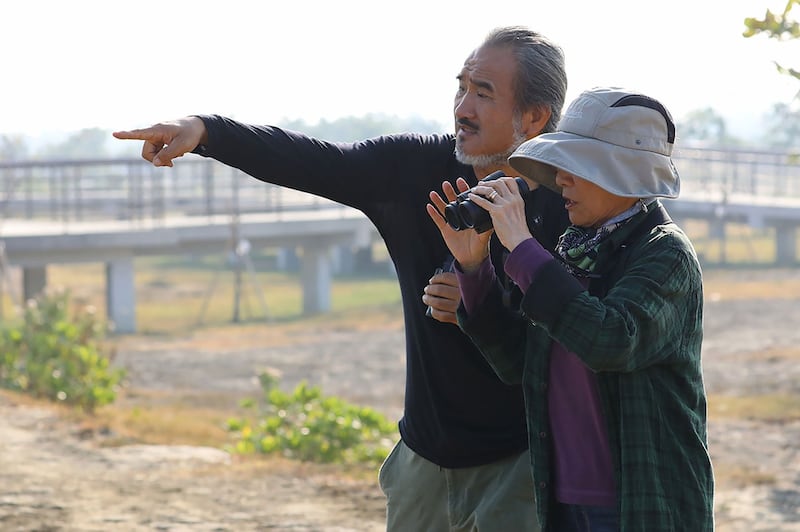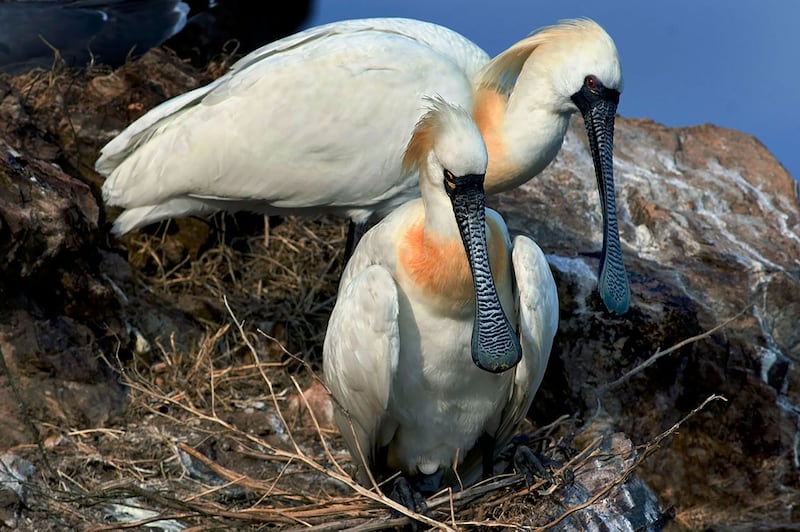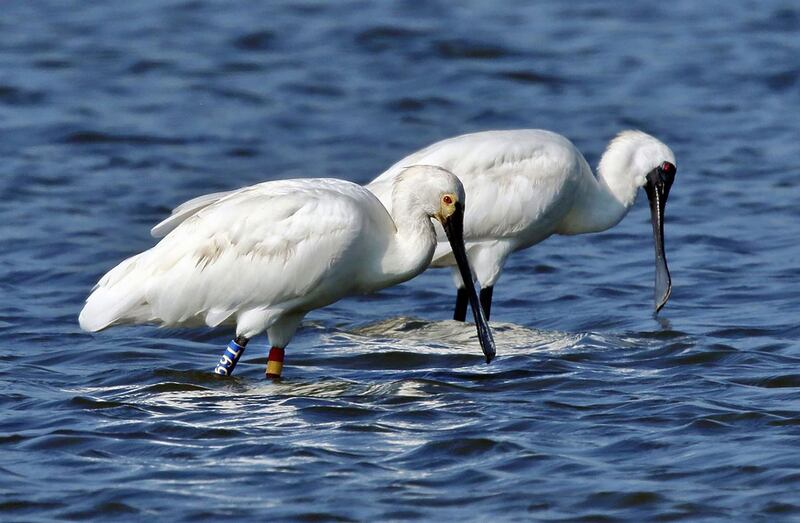Taiwanese wildlife cinematographer and film director Chieh-te Liang, whose work has appeared on TV networks around the world and garnered Golden Horse nominations at home, has spent the last three decades following and filming the black-faced spoonbill, an endangered migratory wading bird that winters on his doorstep.
The result, a feature-length documentary titled "Caring for the Black-faced Spoonbill Together," is an impassioned call for governments and communities to do everything they can to preserve the wetland habitats that are so crucial to the birds' survival.
Much of the footage is filmed in Taiwan, which welcomes the world's largest population of spoonbills every winter, where they grow out their golden plumage and breed, before they head back to Korea and northeastern China for the summer.
"The most important thing for them is habitat," Liang told Radio Free Asia in a recent interview. "If there is no habitat, they are like human beings without a home."
He cites South Korean ornithologist Kisup Lee’s recent habitat restoration project, in which local conservationists piled up leaves and branches on an artificial island to encourage the birds to nest there.
In recent years, the site has become home to more than 100 breeding pairs, he said.
"The black-faced spoonbill population will grow steadily now, and that's partly due to Dr. Lee, who helped a lot of birds that had nowhere else to breed," Liang said.
Conservation success story
To a certain extent, the black-faced spoonbills have been a conservation success story. Back in the 1990s, there were fewer than 300 of the species in the world, while more than 6,000 were recorded in 2022. However, the bird is still on the red list of most endangered species.
Lee has been a loyal camp-follower of the birds for 30 years, pitching up to observe and film them in South Korea, Japan, China, Macau, Hong Kong and Vietnam, among other places.
"Basically, when you're shooting birds, everything depends on the weather," he said. "[Also] there must be no man-made disasters."

That can mean crowds of tourists, or even other birdwatchers, who increased in number once the news of the black-faced spoonbill's plight became more widely known, he said.
"There were about four or five pairs of black-face spoonbills [on Xingrentuo Island]," Liang said in a reference to a small island off the coast of Xulingzhen, some 140 kilometers (87 miles) southwest of Dandong city near the border with North Korea.
"But then lots of people started going to the island and disturbing the birds, and we later found that there were basically no birds breeding there any more," he said. "But the population of black-faced spoonbills gradually recovered, and there were more than 140 on that island last year."
Protecting breeding habitats
Liang first started observing the black-faced spoonbill in 1992, when he had a job as assistant to Liu Hsiao-ru, a zoologist at Taiwan's Academia Sinica, who convened experts from around the world to come up with a plan to protect the birds in their winter breeding habitats.
"It made sense to protect the black-faced spoonbill, a migratory bird, at the place where it winters, its breeding grounds," Liang said.
"China's coastline is very densely populated and was under large-scale development [at that time], and had lost a huge amount of wetlands and other habitat," he said. The species is also dependent on very few habitats in the winter months, he added.
"More than half of the world's black-faced spoonbills [winter] along the southwestern coast of Taiwan," he said. "If that habitat had gone, there would have been nowhere for them to go."

Taiwan's conservationists have stood up to oppose development after development that threatened the spoonbill's breeding grounds since then, Liang said, helping to set up the Taijiang National Park in 2009 to protect them further.
The plan appears to be working, with Taiwan recording a record-breaking 3,824 black-faced spoonbills on its territory in 2022.
Filming the spoonbill
Liang's film offers an intimate look at the breeding patterns of the birds, showing male and females taking turns to sit on the eggs, as well as the eggs being laid in the first place, filmed at the Xingrentuo site off the coast of northeastern China.

Filming may have been on his doorstep, but it was never easy, requiring more than 10 trips just to get the footage for that section of the film.
"There is often a lot of thick mist in April around that area, and we had thick fog several times, so we were unable to even set off," Liang said. "Getting there was a lot of trouble."
"First I took a car from Dalian to Zhuanghekou, then a boat to Shicheng Island, then another boat from there to Xingrentuo," he said.
While numbers are recovering, new threats to the birds' habitats are also emerging, including "green" energy facilities, the reclamation of tidal flats and climate change, he said.
In his native Taiwan, a shift from fishing to fish-farming has affected the spoonbills' access to some of their favorite foods, such as milkfish. Conservationists have persuaded some fish-farmers to use shallower ponds to give the wading birds a chance at some of the fish, and to leave out fish waste to supplement their diet, Liang said.
Solar panel projects
Solar panel farms have also been intruding into the birds' habitat at Yentian Wetland in Chiayi, he said.
"We're not against green energy, but if solar panels are installed in inappropriate places, it can endanger the habitats of birds," Liang said. "The birds completely disappeared from [the area] after they put the solar panels there, because the habitat was completely changed."

Since then, the Taiwan Ornithological Society has negotiated with the government to suspend further solar power projects in the wetland areas, and has now taken over management of the habitat, Liang said.
"I learned persistence from everyone who cares about black-faced spoonbills," Liang said. "You have to keep doing what you think is right."
"We birdwatchers have a saying that what affects birds today will affect people tomorrow," he said. "We should all pay more attention to the creatures around us ... because changes there are closely bound up with the future of humanity."
Translated by Luisetta Mudie .
